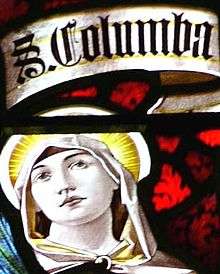Columba of Cornwall
Saint Columba the Virgin is a female saint with dedications in Cornwall and other Celtic regions. She probably lived in the 6th century.
- See Columba (disambiguation) and St Columb (disambiguation) for other uses.
Saint Columba the Virgin | |
|---|---|
 From stained glass window at St. Columb Major church | |
| Virgin & Martyr | |
| Born | very late 5th century possibly Lothian, Scotland probably |
| Died | 6th century Ruthvoes, Cornwall |
| Venerated in | Roman Catholicism; Anglican Communion |
| Major shrine | St Columb Major |
| Feast | 11 November/15 November |
| Attributes | female carrying a palm branch and a sword, a dove hovering above |
The Legend
The legend of Saint Columba, the Virgin, is recorded in a manuscript in the University Library of Cambridge, written by Nicholas Roscarrock in the reign of Elizabeth I and he says he gathered it from local information.[1]
This document states that Columba was the daughter of King Lodan and Queen Manigild, both pagans. She became a Christian when the Holy Ghost appeared to her in the form of a dove. The Latin word for dove is 'columba'. When she refused to marry a pagan prince, her parents had her imprisoned. She escaped with the help of an angel and took ship for Cornwall but was followed by the prince. She landed at Trevelgue Head and was pursued through the forest which is now Porth Beach, and fled up the valley, past Rialton and Treloy until she was captured at Ruthvoes, two miles south of St Columb Major. There the prince cut off her head,[1] and where the blood fell a spring gushed forth and the water following the course of her flight made the still unnamed river which empties itself at St Columb Porth.[2] Orme points out that Ruthvoes' meaning derives from "red bank", whose red soil may have suggested the location and manner of the martyrdom.
Analysis
This legend bears many parallels with the legend of Saint Columba of Sens and the Greek legend of Arethusa a nereid (a water nymph).
Columba is a popular Irish name and Sabine Baring-Gould thought she was really a man. David Nash Ford suggests her parents, Lodan and Manigild, are corrupt forms of Lot and Morgause of Arthurian legend.
Veneration
Her cult was centered on the nearby churches St Columb Major, and St Columb Minor,[3] where her feast day is on 11 and 15 November respectively. (The saint honored at Plougoulm, Brittany is male.)
See also
The following Celtic saints have similar legends in that they were all maidens who were pursued and killed by pagans. All suffer decapitation where springs or wells then miraculously gushed forth from the spot.
- Saint Columba of Sens (France)
- Saint Columba of Spain
- Saint Eluned of Wales
- Saint Urith of Chittlehampton, Devon
- Saint Winefride of Flintshire in Wales
For a variation of the beheading legend see Saint Decuman
Notes
- Orme, Nicholas. "Columb", The Saints of Cornwall, Oxford University Press, 2000 ISBN 9780191542893
- Ross, David. "St Columb Major, St Columba's Church", Britain Express
- Monks of Ramsgate. “Columba”. Book of Saints, 1921. CatholicSaints.Info. 12 October 2012
